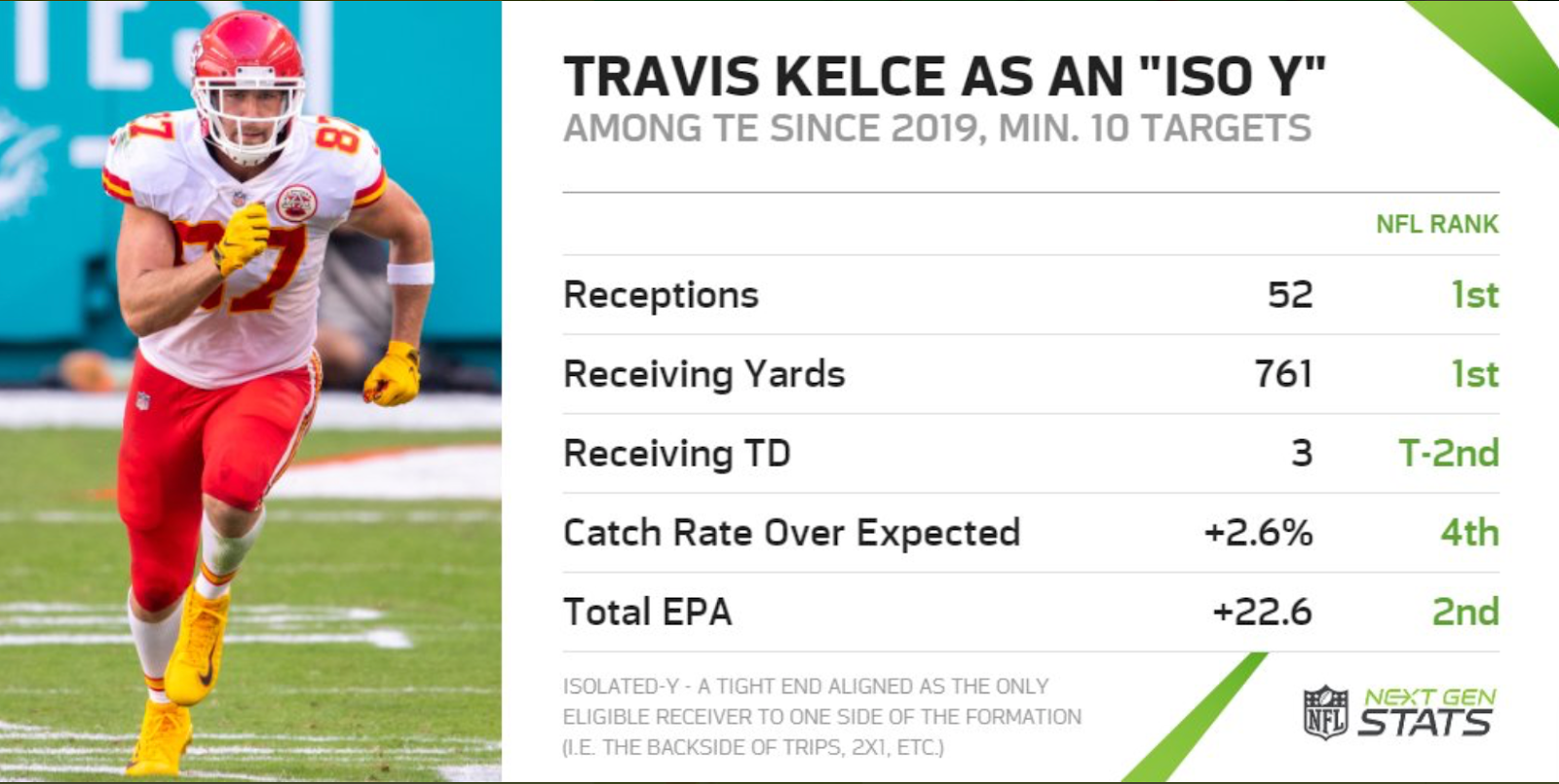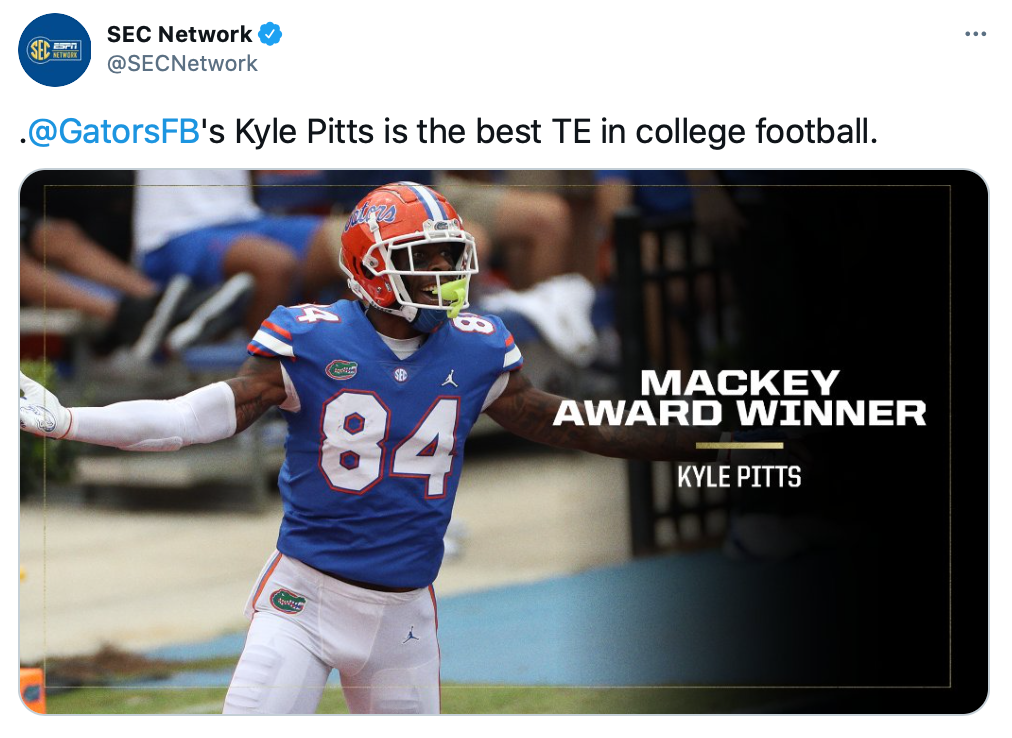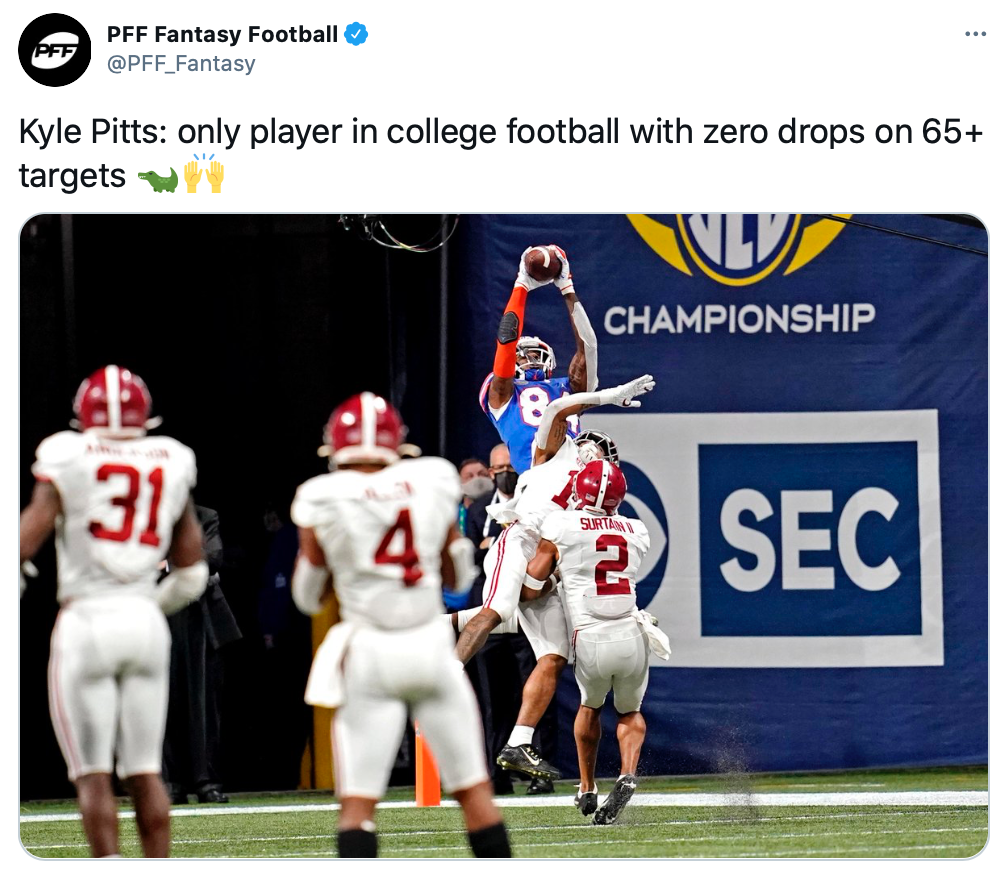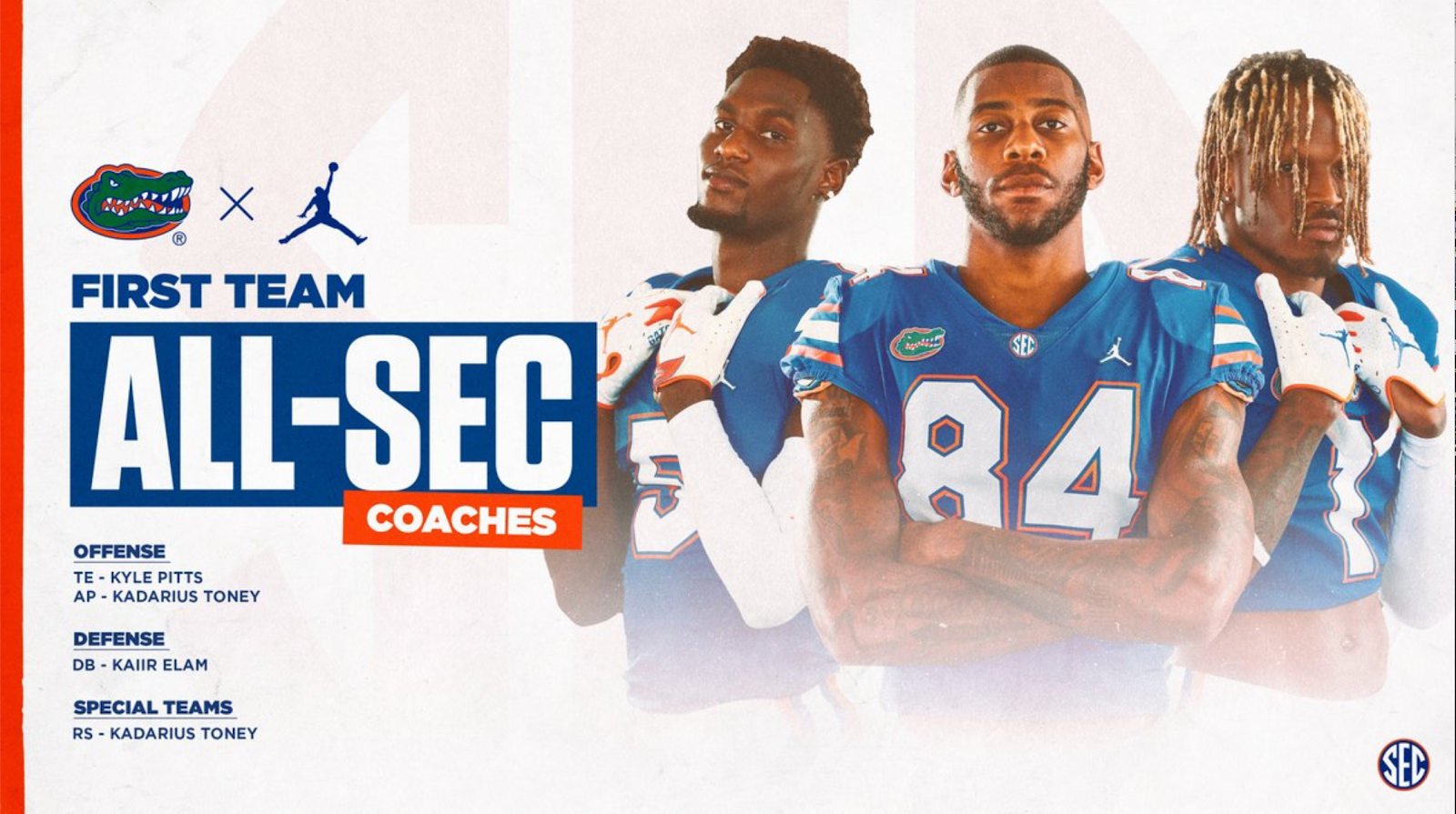Kyle Pitts
TE | Florida Gators | 6-5 | 239 lbs.
Tight End History
Before we dig into the story on Kyle Pitts, let’s touch on the difference-making potential in fantasy from truly special performers at the tight end position. For anyone with a reasonable amount of fantasy experience, one thing is remarkably clear: the dearth of consistent production out of the tight end position is severe.
In the vast majority of cases, we simply waste our time researching TE prospects since they so rarely offer results worthy of the time invested. In Devy formats, you focus your time drafting NFL starters, and simply wait until rookie drafts to add your TE depth. A grand total of two qualified tight ends have scored an average of 20 or more FPG (PPR scoring) in a single season over the last 20 years. Rob Gronkowski did it in 2011 (20.7) and Travis Kelce submitted the second such result with 22.2 FPG this season. The 18.4 FPG entered by Darren Waller this season ranks as the fifth-best mark over those same 20 years. Only 29 TEs have averaged at least 15 FPG in a season over the last 20 years.
In comparison, 45 wide receivers have averaged 20 or more FPG during that time, with Davante Adams (26.4), Tyreek Hill (21.9), and Stefon Diggs (20.9) accomplishing the feat this season. What factors could help us in predicting these rare occurrences? Avenues towards attempting to predict a TE averaging close to 20 FPG would begin and end with looking at Kelce and Waller repeating their 2020 results.
But we can pull some helpful information out of how that pair succeeded. For Kelce, he averaged 14.9 FPG, or 67%, of his scoring average from a detached alignment (separated from the O-line). Nobody compares to “Zeus” as to what essentially amounts to a 6-foot-5, 260-pound WR who previously ran a 4.61 40 time at his University of Cincinnati Pro Day in 2013. Kelce ran 245-of-606 (40%) routes out wide this season. The next highest player on the list was Waller, with 151-of-559.
Waller ran 50% of his routes this season from a detached alignment. Waller was listed as a WR for Georgia Tech’s former triple-option offense at 6-foot-6, 241 pounds. At the 2015 NFL Combine, he ran a 4.46 40 time. Kelce averaged 17.7 FPG or nearly 80% of his scoring with 11 personnel on the field. Waller averaged 9.9 FPG, or 51%. That information tells us that the pair benefited when the offense employed increased spacing. The pair also finished first and second in air yards/game (93.0 for Kelce, 76.3 for Waller). But Travis and Darren finished 13th and 27th, respectively, in air yards/target (AY/T). How can that be explained?

Well, Kelce collected 12 FPG or 54% of his scoring on hitches, outs, slants, and crossers — a combined average of 8.2 AY/T. Whereas Waller totaled 10.6 FPG or 58% of his production on speed outs, crossers, slants, and hitches — a combined average of 5.1 AY/T. That’s a ton of production on routes with mostly shorter stems. NFL TEs averaged well over half of all routes run from that Kelce quartet, nearly the identical number on Waller’s most common routes. This is an extremely revealing data point. While it will also read as obvious, it is still of monumental importance when evaluating TE prospects. One of the most significant factors fueling top TE results is not from a bloated AY/T average, it can be attributed to featured involvement within the offense. Volume is king, and not just at the running back position.
Kelce also led NFL TEs with 12.6 FPG, or 57%, of his scoring on plays where he was in motion. Waller averaged 7.2 FPG, or 39%, in those situations. Waller led all NFL TEs this season with a 27% target share. Kelce finished second at 23%. However, not all target shares can be compared evenly. Kansas City passed on 740 plays, Las Vegas on 646. Gronkowski’s ‘11 season and Waller’s ‘20 prove inline TEs can still generate special results. But they will be the most difficult to predict.
To summarize, with a very promising incoming class of tight ends, in addition to landing in a perfect situation, we hope to see:
- Speed. Not all speed is equal. Weight-adjusted speed is the ultimate key.
- Evidence of production from a detached alignment.
- Ability to produce on “NFL routes.”
- Coordination to motion across the formation to maximize mismatching purposes.
- Featured role in passing game plan.
Unfortunately, the fifth factor can’t be evaluated into existence. Gronk (2.10), Kelce (3.01), and Waller (6.27) were each drafted outside of the first round. Over the last 10 seasons, T.J. Hockenson, Noah Fant, Hayden Hurst, O.J. Howard, Evan Engram, David Njoku, Eric Ebron, and Tyler Eifert are al thel TEs selected in the first round. The combined group has averaged 4.96 targets/game and 79.3 targets/season — nearly half of the target rates from Kelce and Waller this season. If you go further back, those first rounder rates will massively decrease. Only Engram averaged more than 8.0/game (2019) or more than 7.0/game (2017). We simply cannot expect first-round TEs to be handed featured targets based on draft capital alone.
These guidelines are far from perfect, but they do provide us with a starting point. NFL offenses will continue to evolve, forcing us to follow suit with our evaluation process.
The Story
The majority of top TE prospects take an uncoordinated path to that end… frankly, as uncoordinated as their bodies following common late growth spurts. Pitts’ path to college was much of the same. Prior to his junior season, he transferred to Archbishop Wood, a top-150 nationally ranked school. It’s one of the top football schools in Pennsylvania — ranked No. 4 during Pitts’ senior season —- under the direction of HC Steve Devlin. Devlin fell in love with Pitts’ ability, so much so that he played him on both sides of the ball. Pitts aided his team toward securing PIAA Class 5A Championships in both of his seasons with the Vikings. He produced modest receiving statistics by fantasy standards, with the Pro-Style offense heavily focused on its running game.
Devlin also felt that Pitts had the ability to play either TE or DE in the Power 5. But Pitts was determined to make his way on offense, specifically at TE. It wasn’t until he attended a camp at Temple University that the FBS scholarship offers started pouring into his mailbox. By the end of his recruiting cycle, Pitts had been offered by Alabama, Ohio State, Georgia, Oklahoma, Miami (FL), and 15 other programs. But Pitts had his sights set on playing for the Florida Gators. Even after former HC Jim McElwain was dismissed in 2015, Pitts remained loyal. He discussed the situation with one of the coaches who convinced him to sign with UF, Ja’Juan Seider, who assured him that he would continue to be in good hands under new HC Dan Mullen. (Seider is now the running backs coach — and one of the top recruiters — at Penn State.)

We all know that the path for Pitts played out perfectly in his favor, but his body development was still in the works during his true freshman season. Pitts would play the majority of his 11 games on special teams in 2018. That’s not uncommon — tight ends tend to take more time to develop at every level (how often do rookie TEs put up big numbers in the NFL?).
Pitts, however, seemed to display a much quicker maturation process. The very next season, he was an All SEC First-Team selection by the Associated Press. Two years later, he garnered the Mackey Award, a unanimous First-Team All American selection, finished in the top-10 in the Heisman voting, was a semifinalist for the Walter Camp and Maxwell Awards, and became the only TE in history to be a finalist for the Biletnikoff Award.
Fun trivia: Pitts was told at his first high school, Abington, that he did not possess the coordination to play the TE position. His coaches wanted him to focus on playing QB. Pitts would transfer to Archbishop Wood at the conclusion of that season.
The Attributes
When Pitts recorded a 4.70 second 40-yard dash time at 6-foot-6, 240 pounds at the ‘17 Nike Opening in Beaverton, Oregon, his ticket toward becoming a top TE prospect had been punched. Speed measurements are always worthless without film backing up the ability… and that is precisely what Pitts put on tape at Archbishop Wood. I am blown away with his junior highlights. Before we dig in, keep in mind that he does not have the benefit of facing vanilla competition. In high school, he was obviously yet to develop the sharp route-running that would leave such a mark at Florida this season, but his hands appear to be just as strong as today. And he appears perfectly comfortable in a three-point stance, attached to the O-line in his very first season at the position.

The speed that we desperately need to see to project future fantasy stardom is already evident. I also completely agree with his Archbishop Wood coaches concerning his talent at DE. I know the idea of playing Pitts on special teams will fall against the wishes of his future NFL offensive coaches. But he could be a monster rushing punts in the NFL with his long arms and edge-bending ability around blocks. Another of the factors that we want to see from our TEs is success on NFL routes. Many of his catches during his junior season are on crossers over the middle. Not only does Pitts display the awareness to find holes in the zone coverages, he’s able to locate the ball, and keep his body under control to work after the catch.
With his senior highlights, we see Pitts with a full year of experience under his belt at TE. The most notable difference is the growth within his frame. Truly scary. Check out the play at 0:33. Yes, it’s a tunnel screen — not an NFL route for TEs — but it highlights the additional muscle he’s added to that frame. The speed from this kid is remarkable. Evan Engram is fast. Pitts appears just as fast with three more inches of height to him, with additional room to add muscle.
Our very first example of a deep target to Pitts isn’t shown until the 0:53 mark, completely handling a CB in man coverage on the back-shoulder go. I am not anticipating that we’ll see Pitts utilized much on deep passes but, as I’ll get to in a bit, his ability against man coverage is truly special. An additional example is shown at 3:46.
We can also see that, at this stage, Pitts has become entirely comfortable lining up wide. He is simply a man amongst boys with his eyes up, locked onto the end zone with every touch. Playing within the Pro Style offense certainly helped with his learning curve. The video closes with a multitude of examples with Pitts on inline targets: 7:49, 8:06, 8:47, and 9:08. As you can see, these routes can be very different, especially at 7:49 and 8:47, requiring Pitts to anticipate contact from behind. These routes limit usage of his jump-cut ability. Pitts will be asked to play these inline snaps in the NFL. Judging from these Archbishop Wood highlights, to say I am blown away by Pitts would be a massive understatement.
Jumping ahead to footage of Pitts’ sophomore season with the Gators, how can we not love the hitch against man at 0:25? This is the exact route we will need Pitts to master in the NFL. Yes, he lets the ball get into his body. That is something scouts questioned coming out of high school. We want to see him collecting these with his hands, but sometimes that option can be eliminated by the coverage defender. It’s only an issue when they lead to drops. We do have several further examples present in his sophomore tape (1:23, 3:03, etc.,).
Facing Kentucky’s Cover 3 at 0:52, we see Pitts continuing to use a crossing route to identity zone holes. Beautiful. These gaps in zone coverage will show up on every play, but recognition can be tricky.
At 1:11, Tennessee is masking Cover 6 as Cover 3, a mistake against Pitts — he takes full advantage with excellent recognition from Kyle Trask. Had they closed off the middle in Cover 3, the deep safety would’ve been all over this seam route. You can see the Will (weakside) LB attempting to maintain inside leverage on Pitts to protect the middle of the field. Pitts tosses the LB aside, making the result possible, and making it look easy to boot. The full extension to complete the catch is dazzling. Four weeks into his first season as a starter, the nation has now been indoctrinated on Pitts’ arrival.
I referenced this play above (1:23) as allowing the pass into his body. Pitts destroys the mismatched 5-foot-11, 181-pound Bryce Thompson’s jam attempt in man coverage. The fact that he doesn’t snag this with his hands can be considered preference. Skipping past all of the Towson footage (which is of little value, given the competition level) we see Auburn CB Roger McCreary (6-foot, 188 pounds) in man at 2:09. Pitts utilizes a skinny post while tossing the mismatched CB aside. On the very next play (2:29), Pitts is defended in man by LSU star CB Derek Stingley Jr., and he utilizes another skinny post with excellent results. These two face off again at 3:14, Stingley doing everything he can to separate Pitts from the ball on yet another post.
Just as we’ve already seen numerous times before, these 40-50 pound mismatches do not end well. But these defenses have no choice. Pitts is so obviously athletic that coordinators fear covering him with LBs. On the very next play (2:40), LSU DC Dave Aranda pulls down safety Grant Delpit on Pitts. Using an out-and-up route, Pitts gives an ever-so-slight shove on Delpit to create space for the big play. Delpit’s best efforts to be physical with Pitts entirely justifies the return shove. This game against LSU stands as Pitts’ first career 100-yard performance.
With Georgia in Cover 2-Man at 3:57, Pitts reminds us how much of a mistake it can be to utilize LBs in coverage, here with Monty Price paying the price. At the 4:19 mark, Richard LeCounte takes a horrific angle on Pitts in Cover 2-Man. The biggest takeaways from his sophomore footage are that he’s grown into his frame without losing anything in speed. We’ve yet to see a single defense figure out the proper way to defend the mismatch waiting to happen. With only four drops the entire season, we really haven’t seen Pitts suffer from consistently allowing the ball into his body. Since he collected every single catchable target during his junior season, I really don’t think we can consider that as a flaw, moving forward.
Switching over to Pitts’ junior season highlight reel, we see Pitts getting off to an amazing start facing the defensive-deficient Ole Miss Rebels. 6-foot-2, 220-pound safety Jay Stanley is embarrassed by Pitts’ physicality at 0:28 on the back shoulder go. Just in case opposing defenses needed another reminder why LBs should not be responsible for Pitts, Trask stares down his go-to target as he gets behind the entire defense in Cover 3 for a 70-yard scoring strike. At this point, we can see that Pitts has recognized just how much difficulty opposing defenses are having in coverage. He’s pushing his routes further downfield, treating SEC defenders like those he faced at Archbishop Wood during his senior season.
You’ll need to watch individual game footage, but Pitts’ run blocking technique has also greatly improved over the liability from his sophomore season. We can expect to see him follow a similar transition in the NFL. However, I do not feel he will need as much time for his route running, receiving production to translate. Defenders at the next level will have just as much difficulty handling Pitts on the shorter stuff. He just plays too fast for a kid his size to cover in man. The one aspect that might give him the most trouble is facing the better zone coverages. If that proves to be the case, it’ll be due to defenses -- equipped with excellent coverage LBs -- scheming specifically to slow him down. All the same, it will allow other playmakers to benefit.
Jumping ahead to 1:50 facing a talented Texas A&M defense, we see safety Leon O’Neal Jr. in man on Pitts. You can see just how much trouble O’Neal has with that speed out of the break. If we see Pitts test with a 37-38 inch vertical at his Pro Day, he could force his way into being a top-five pick, maybe even higher.
“Unguardable” might be the perfect nickname for Pitts. Looking at the plays at 2:17 and 2:34 facing Georgia, Pitts can be seen manipulating his coverage unlike any TE I’ve seen in college football. This is next-level body control from a junior in college. Truly remarkable. He also appears to be faster than defenders who should have the speed advantage. Just look at what he does at 3:42. For a player his size, the footwork to generate these moves are unheard of in the mortal realm.

I had already made the decision to cut my individual play analysis of his junior footage off after the Tennessee game. When I rewatched the SEC Championship, Pitts simply took my breath away. The stuff he did in the Alabama game cannot be described with words. The Crimson Tide were fortunate to have escaped that game with the victory. Watching that game in real time failed to leave the same impression I came away with on second viewing. Pitts may be the most talented college TE I have seen in my 43-year lifetime. I cannot even begin to envision how much his stock will skyrocket leading up to the draft.
Fantasy Fit
32 NFL teams will be interested in drafting Pitts. No exaggeration. That includes both Kansas City and Las Vegas. Should Pitts test out the way I think he will at his Pro Day, he could end up being selected at No. 3 behind Trevor Lawrence and Justin Fields. As much as I love Fields, I wouldn’t even be shocked if he is taken at No. 2.
I will make no effort in likening Pitts to another player. Gronk and Kelce are too big. Waller and Engram may seem like close fits, but they simply fall short of the unified skillset from Pitts. Let alone from a college production standpoint.
The Bottom Line
QB play will be the limiting factor wherever Pitts is drafted. If Pitts lands with a top-five QB, he could break rookie TE records. Any NFL team attempting to play man coverage on Pitts is going to be sorry. Playing within the right offense, opposing defenses will be forced to specifically scheme to contain him. Judging from what I’ve seen on tape, Pitts is entirely without a ceiling. I’m not going to mince my words. We have one of the most uniquely gifted TEs in the history of the game.
Evaluating Pitts from the four keys to TE fantasy success listed above: (1) Speed? Without question. (2) Ability to excel from a detached alignment? Do I really need to answer that one? (3) Ability to produce on “NFL routes.” Affirmative. (4) Proper coordination to motion across the formation to maximize mismatching purposes? Perhaps like no other in the game sans Kelce. (5) Featured role in passing game plan? Unknown. Sans Superflex formats, as sold as I have been with Najee Harris at No. 2 in the overall dynasty rankings, I am left with no other choice but to move Pitts ahead of him. In 1.5 PPR TE scoring leagues, you are taking Pitts first overall, and not looking back.
If Pitts remains healthy, the only factor I can envision limiting his rookie upside is landing with a team that refuses to leave him on the field full-time, while his run blocking develops. We need Pitts on the field on both play action and RPOs in order to justify selecting him first overall. I will draw the line, at this stage, in keeping Ja’Marr Chase at the top of the ranks. In my view, Chase is landing spot-independent, able to produce in Year 1 no matter the QB.
However, prior to film study, I was utterly convinced no one would challenge Chase for my rankings. Pitts has done his best to change that.







